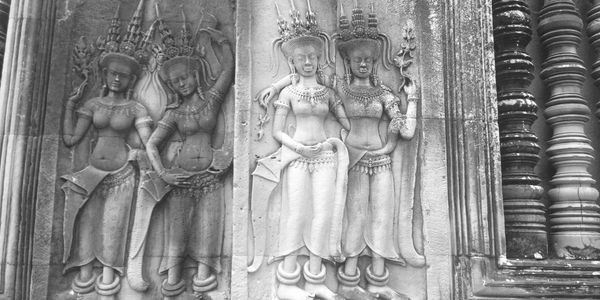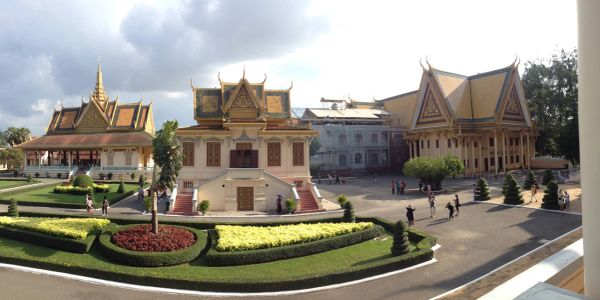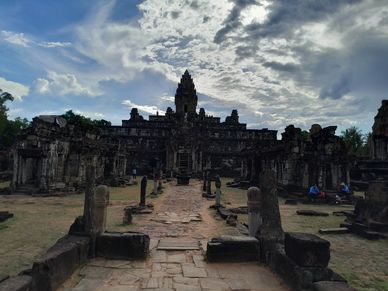Cambodia
Angkor Wat

The largest temple complex ever built by human race!
Siem Reap

Great nightlife in Siem Reap, Cambodia
Phnom Penh
A village in Cambodia
A village in Cambodia

Phnom Penh : The capital city of Cambodia.
The Royal Palace of Cambodia
A village in Cambodia
A village in Cambodia
A village in Cambodia

More stories coming soon!
Kindly subscribe to the blogs!
Angkor wat
Angkor Wat

It is regarded as one of the best examples of Khmer architecture and a symbol of Cambodia, depicted as a part of the Cambodian national flag.
Angkor Wat

Angkor Wat was built at the behest of the Khmer king Suryavarman II in the early 12th century in Yaśodharapura (present-day Angkor), the capital of the Khmer Empire, as his state temple and eventual mausoleum.
Angkor Wat
Angkor Wat

The temple complex fell into disuse before being restored in the 20th century with various international agencies involved in the project.
Angkor Wat
Angkor Wat

The temple is admired for the grandeur and harmony of the architecture, its extensive bas-reliefs and devatas adorning its walls.
Angkor Wat

The temple is admired for the grandeur and harmony of the architecture, its extensive bas-reliefs and devatas adorning its walls.
Angkor Wat

The temple is admired for the grandeur and harmony of the architecture, its extensive bas-reliefs and devatas adorning its walls.
Angkor Wat

Ta Reach (the Royal Ancestor), originally an eight-armed statue of Vishnu
Angkor Wat

The temple is admired for the grandeur and harmony of the architecture, its extensive bas-reliefs and devatas adorning its walls.
Angkor Wat
Angkor Wat

Churning of the Sea of Milk scene
Angkor Wat
Angkor Wat
Angkor Wat

Angkor Wat
Angkor Wat
Angkor Wat
Angkor Wat

Angkor Wat
Angkor Wat
Angkor Wat
Angkor Wat

Angkor Wat
Bayon temple
Bayon temple

The Bayon Temple, located in Angkor Thom, Cambodia, has 216 huge stone faces carved on its towers. These faces are a distinctive feature of the temple and are often depicted as smiling. The temple has a total of 54 towers (believed to be each created for 54 major cities in the kingdom), with each tower having four faces.
Bayon temple

The Bayon Temple, located in Angkor Thom, Cambodia, has 216 huge stone faces carved on its towers. These faces are a distinctive feature of the temple and are often depicted as smiling. The temple has a total of 54 towers (believed to be each created for 54 major cities in the kingdom), with each tower having four faces.
Bayon temple
Bayon temple

The Bayon Temple, located in Angkor Thom, Cambodia, has 216 huge stone faces carved on its towers. These faces are a distinctive feature of the temple and are often depicted as smiling. The temple has a total of 54 towers (believed to be each created for 54 major cities in the kingdom), with each tower having four faces.
Bayon temple
Bayon temple

Angkor Thom
Bayon temple

Angkor Thom
Bayon temple

Angkor Thom
Bayon temple

Angkor Thom
Bayon temple

Angkor Thom
Bayon temple
Bayon temple

Angkor Thom
Bayon temple
Bayon temple

A scene from the eastern gallery shows a Khmer army on the march.
Bayon temple

Angkor Thom
Bayon temple

Angkor Thom
Ta Prohm Temple
Ta Prohm Temple

The temple is referred to as the "Tomb Raider Temple" or the "Angelina Jolie Temple" due to its depiction in the film Lara Croft: Tomb Raider (2001).
Ta Prohm Temple

Ta Prohm Temple
Ta Prohm Temple
Ta Prohm Temple

Ta Prohm Temple
Ta Prohm Temple
Ta Prohm Temple
Ta Prohm Temple

Ta Prohm Temple
Ta Prohm Temple
Ta Prohm Temple
Ta Prohm Temple

Ta Prohm Temple
Ta Prohm Temple
Ta Prohm Temple
Ta Prohm Temple

Ta Prohm Temple
Ta Prohm Temple
Banteay Kdei temple
Banteay Kdei temple

Ta Prohm Temple
Banteay Kdei temple
Banteay Kdei temple
Banteay Kdei temple

Near Ta Prohm
Banteay Srei
Banteay Srei
Banteay Srei
Banteay Srei

Banteay Srei is a 10th century CE Cambodian temple dedicated to the Hindu gods Shiva and Parvati. Located in the area of Angkor, it lies near the hill of Phnom Dei, 25 km (16 mi) north-east of the main group of temples that once belonged to the medieval capitals of Yaśodharapura and Angkor Thom.
Banteay Srei
Banteay Srei
Banteay Srei

Banteay Srei is built largely of red sandstone, a medium that lends itself to the elaborate decorative wall carvings which are still observable today.
Banteay Srei
Banteay Srei
Banteay Srei

The buildings themselves are miniature in scale, unusually so when measured by the standards of Angkorian construction.
Banteay Srei
Banteay Srei
Banteay Srei

Considered by many to be the jewel in the crown of Angkorian art, Banteay Srei is cut from stone of a pinkish hue and includes some of the finest stone carving anywhere on earth.
Banteay Srei
Banteay Srei
Banteay Srei

The temple's modern name, Banteay Srei—citadel of the women, or citadel of beauty—is probably related to the intricacy of the bas relief carvings found on the walls and the tiny dimensions of the buildings themselves.
Banteay Srei
Banteay Srei
Banteay Srei

The temple's modern name, Banteay Srei—citadel of the women, or citadel of beauty—is probably related to the intricacy of the bas relief carvings found on the walls and the tiny dimensions of the buildings themselves.
Banteay Srei

Banteay Srei
Banteay Srei

Banteay Srei
Banteay Srei
Banteay Srei

Banteay Srei
Banteay Srei
Banteay Srei
Banteay Srei

Banteay Srei
Banteay Srei
Banteay Srei
Banteay Srei

Banteay Srei
Banteay Srei
Banteay Srei
Banteay Srei

Banteay Srei
Phnom Kulen National Park
Kulen Mountain
Kulen Mountain
Kulen Mountain

Beyond Angkor
Kulen Mountain
Kulen Mountain
Kulen Mountain

Phnom Kulen waterfalls
Kulen Mountain
Kulen Mountain
One thousand Lingas

Phnom Kulen waterfall
One thousand Lingas
One thousand Lingas

Phnom Kulen National Park
One thousand Lingas

Phnom Kulen National Park
River of one thousand Lingas

Kbal Spean
Valley of one thousand Lingas

Kbal Spean
Preah Ang Thom

Phnom Kulen
Reclining Buddha at Preah Ang Thom
Reclining Buddha at Preah Ang Thom

Phnom Kulen
KOHKER
Koh Ker
Koh Ker
Koh Ker

Koh Ker is a remote archaeological site in northern Cambodia about 120 kilometres (75 mi) away from Siem Reap and the ancient site of Angkor.
Koh Ker
Koh Ker
Koh Ker

Koh Ker is the modern name for an important city of the Khmer empire. In inscriptions the town is mentioned as Lingapura (city of lingams) or Chok Gargyar (translated as city of glance, or as iron tree forest)
Koh Ker
Koh Ker
Koh Ker

View from the top of the pyramid
Koh Ker
Koh Ker
Koh Ker

View from the top of the pyramid
Koh Ker
Koh Ker
Koh Ker

Kohker
Prasat Beng Mealea
Beng Mealea
Beng Mealea

Boeng Mealea, is a temple from the Angkor Wat period located 40 km (25 mi) east of the main group of temples at Angkor, Cambodia, on the ancient royal highway to Preah Khan Kompong Svay.
Beng Mealea
Beng Mealea

Beng Mealea
Beng Mealea

Beng Mealea
Beng Mealea
Beng Mealea

Beng Mealea
Beng Mealea
Beng Mealea
Beng Mealea

Beng Mealea
Beng Mealea
Beng Mealea
Beng Mealea

Beng Mealea
Beng Mealea

Beng Mealea
Beng Mealea

Beng Mealea
Beng Mealea

Beng Mealea
Beng Mealea

Beng Mealea
Beng Mealea
Beng Mealea

Beng Mealea
Beng Mealea
Beng Mealea

Beng Mealea
Other temples in and around angkor
Other temples
Phnom Bakheng temple

other temples
Phnom Bakheng temple
Phnom Bakheng temple

Phnom Bakheng
On the top of Phnom Bakheng temple
View of Angkor Wat from Phnom Bakheng temple

Phnom Bakheng
View of Angkor Wat from Phnom Bakheng temple
View of Angkor Wat from Phnom Bakheng temple
View of Angkor Wat from Phnom Bakheng temple

Phnom Bakheng
Bakong Temple
View of Angkor Wat from Phnom Bakheng temple
Bakong Temple

Roluos group , Hariharalaya
Bakong Temple
View of Angkor Wat from Phnom Bakheng temple
Bakong Temple

The striking similarity of the Bakong and Borobudur temple in Java, going into architectural details such as the gateways and stairs to the upper terraces, suggests strongly that Borobudur was served as the prototype of Bakong.
Bakong Temple

The striking similarity of the Bakong and Borobudur temple in Java, going into architectural details such as the gateways and stairs to the upper terraces, suggests strongly that Borobudur was served as the prototype of Bakong.
Bakong Temple

Bakong
Lolei temple
Lolei temple

Lolei
Lolei temple
Preah Ko "The Sacred Bull" temple
Lolei temple

Lolei
Preah Ko "The Sacred Bull" temple
Preah Ko "The Sacred Bull" temple
Preah Ko "The Sacred Bull" temple

Preah Ko
Other temples
Preah Ko "The Sacred Bull" temple
Preah Ko "The Sacred Bull" temple

Other temples
SIEM REAP
Siem Reap Angkor International Airport
Siem Reap Angkor International Airport
Siem Reap Angkor International Airport

SAI
Siem Reap Angkor International Airport
Siem Reap Angkor International Airport
Siem Reap Angkor International Airport

SAI
Siem Reap at night
Khmer Kitchen Restaurant
Khmer Kitchen Restaurant

Siem Reap
SIHANOUKVILLE
Sihanoukville Railway Station
Sihanoukville Railway Station
Sihanoukville Railway Station

Sihanoukville
Sihanoukville Railway Station
Sihanoukville Railway Station
Sihanoukville Railway Station

Sihanoukville
Sihanoukville
Sihanoukville Railway Station
Sihanoukville

Sihanoukville
Sihanoukville
Sihanoukville

Sihanoukville
Sihanoukville

Sihanoukville
Sihanoukville

Sihanoukville
Sihanoukville
Sihanoukville
Sihanoukville

Sihanoukville
Sihanoukville
Sihanoukville
Sihanoukville

Sihanoukville
Sihanoukville
Sihanoukville

Sihanoukville
Sihanoukville
Sihanoukville

Sihanoukville
Sihanoukville
Sihanoukville
Sihanoukville

Sihanoukville
Sihanoukville
Sihanoukville
Sihanoukville

Sihanoukville
Otres Beach
Sihanoukville
Otres Beach

Sihanoukville
Otres Beach
Sihanoukville
Otres Beach

Sihanoukville
Sihanoukville
Sihanoukville
Independence Beach

Sihanoukville
Independence Beach
Independence Beach
Independence Beach

Sihanoukville
Independence Beach
Independence Beach
Independence Beach

Sihanoukville
Independence Beach
Independence Beach
Independence Beach

Sihanoukville
Independence Beach
Independence Beach
Independence Beach

Sihanoukville
Independence Beach
Independence Beach
Independence Beach

Sihanoukville
Independence Beach
Independence Beach
Independence Beach

Sihanoukville
Independence Beach
Independence Beach
Independence Beach

Sihanoukville
Independence Beach
Independence Beach
Independence Beach

Sihanoukville
Sihanoukville
Independence Beach
Independence Beach

Sihanoukville
Tfortravels
Cookie Policy
This website uses cookies. By continuing to use this site, you accept our use of cookies.